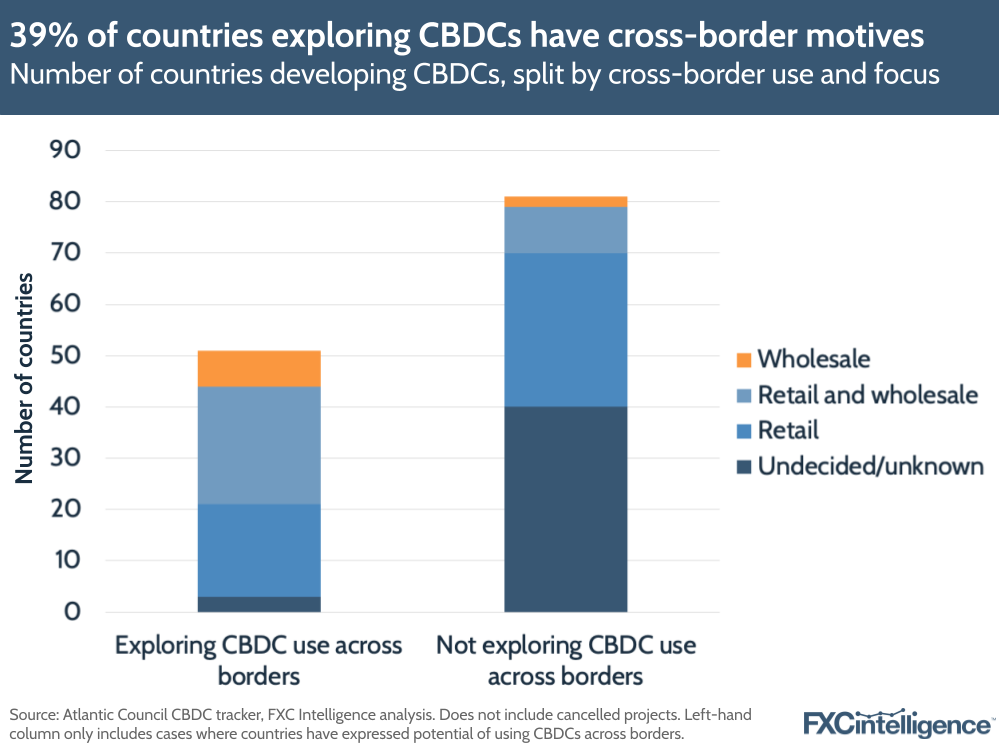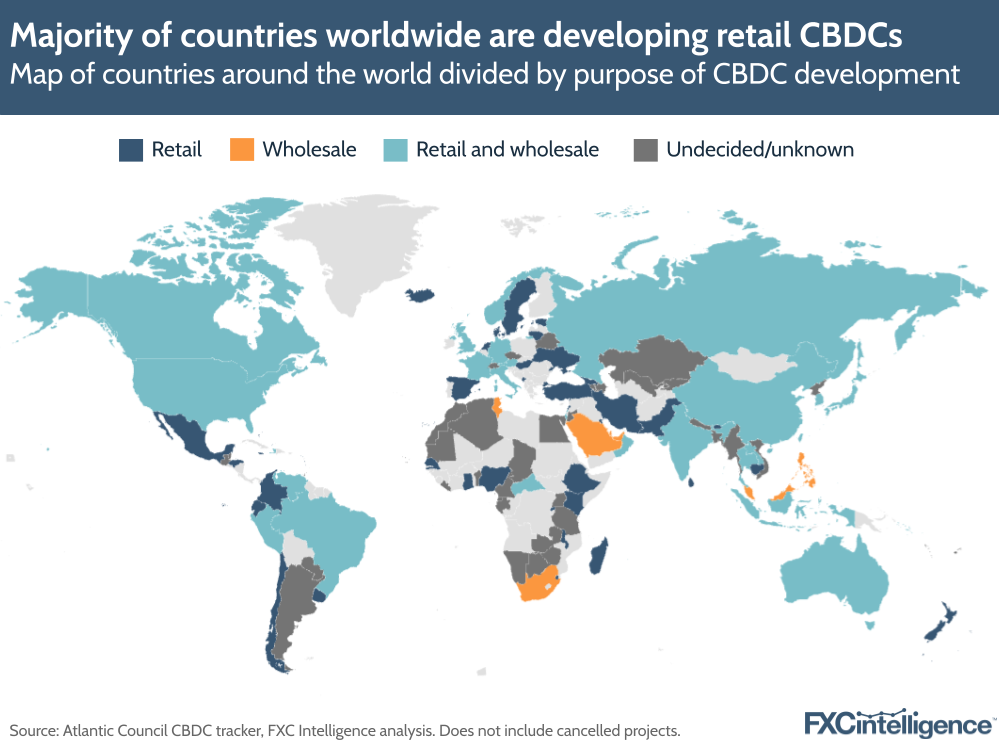Last month, Canada announced it was shelving its retail CBDC project, which came after news that Australia is prioritising wholesale over retail CBDC development earlier in September. We’ve taken another look at the difference between wholesale and retail CBDC projects, and which are currently being discussed more in relation to cross-border payments.

As discussed in a previous CBDC report, retail CBDCs are directly held by individuals and businesses as a digital form of cash and used for P2P and B2B payments, as well as transactions for goods and services. They have been a means of boosting national payment systems and growing financial inclusion – for example, in countries like the Bahamas, Jamaica and Nigeria, where CBDCs have already launched.
Meanwhile, wholesale CBDCs are used to enable transactions between financial intermediaries for interbank transactions, with the focus of these often being on building cross-border connectivity and interoperability. These CBDCs are often at the centre of major projects, such as the Bank for International Settlements’ (BIS) Project mBridge, which aims to create a multi-CBDC platform shared across countries.
How many countries worldwide are working on retail and wholesale CBDCs?
As of the end of September, data from the Atlantic Council shows that out of 134 countries and currency unions (i.e. the EU) that have or are working on CBDCs, 2% have actually launched CBDCs, while 33% are at the pilot stage and 15% are at the development stage. However, a number of projects have also been shelved, with 16% of countries currently having inactive projects, while 1% have cancelled their CBDC initiatives altogether.

Excluding cancelled projects, retail CBDCs are dominating the discussion, with 36% of countries working on retail-focused CBDCs while 23% are focusing on both retail and wholesale CBDC projects. In the latter case, some countries (e.g. Kazakhstan) were looking at the potential of retail on the domestic side, while exploring wholesale CBDCs for cross-border settlement. Meanwhile, only 7% of countries have focused solely on the potential of wholesale CBDC without a clear retail focus.
Across both retail and wholesale CBDC projects, emerging markets are particularly prevalent in CBDC development. Of the total countries developing or having CBDCs, 65% of them were from Africa, Asia or LatAm and the Caribbean. In addition, 63% of retail-focused countries; 56% of wholesale-focused countries; and 48% of combined retail and wholesale-focused countries were from these regions. Meanwhile, European countries and currency unions (including the Euro Area) accounted for 18% of markets in total, with 29% of these having a combined focus on the wholesale and the retail side.
As expected, wholesale projects tended to have cross-border as a significant or at least expressed motivation behind CBDC development, though some countries that are working towards retail CBDCs have also discussed cross-border as a potential motivating factor.
In total, 78% of countries exploring wholesale-focused projects expressed a clear interest for using these in cross-border payments, compared to 74% of retail and wholesale-focused countries and 38% of countries focused on retail projects.
The growth of cross-border interoperability projects
A number of cross-border interoperability projects are ongoing worldwide, with these picking up significant steam in recent times. A number of factors are driving this, including countries trying to compete with digital payments challengers as physical cash declines, sanctions being imposed on payments from some countries (e.g. Russia) and a desire to decrease the power of the US dollar in cross-border transactions.

Out of 18 major CBDC projects listed on the Atlantic Council’s CBDC tracker, 50% of them are based on wholesale CBDCs, versus 39% for retail and 11% focused on both retail and wholesale CBDCs. It is telling that while a growing number of countries worldwide are supporting wholesale CBDC development, most of them are also separately looking into the potential of retail CBDCs.
While CBDCs are a hot topic, there is still some time before many of these plans come to fruition. Developing CBDCs comes at a high cost – from conducting research to developing infrastructures and cybersecurity measures before even considering educating the public – and it’s not surprising that some countries are changing their priorities or taking stock.
What’s relevant for our audience is that of all the countries visibly exploring CBDCs, around 39% have a clearly expressed motivation in improving cross-border payments – whether that’s in their central banks supporting ongoing interoperability projects from the BIS or in the development of their own CBDCs. It’s clear that cross-border remains a sizeable part of the conversation and a key motivator, even in countries that are focused on retail CBDCs, but for many countries the focus is more on driving financial inclusion at home.
How can I track the size of the cross-border markets across these countries?


